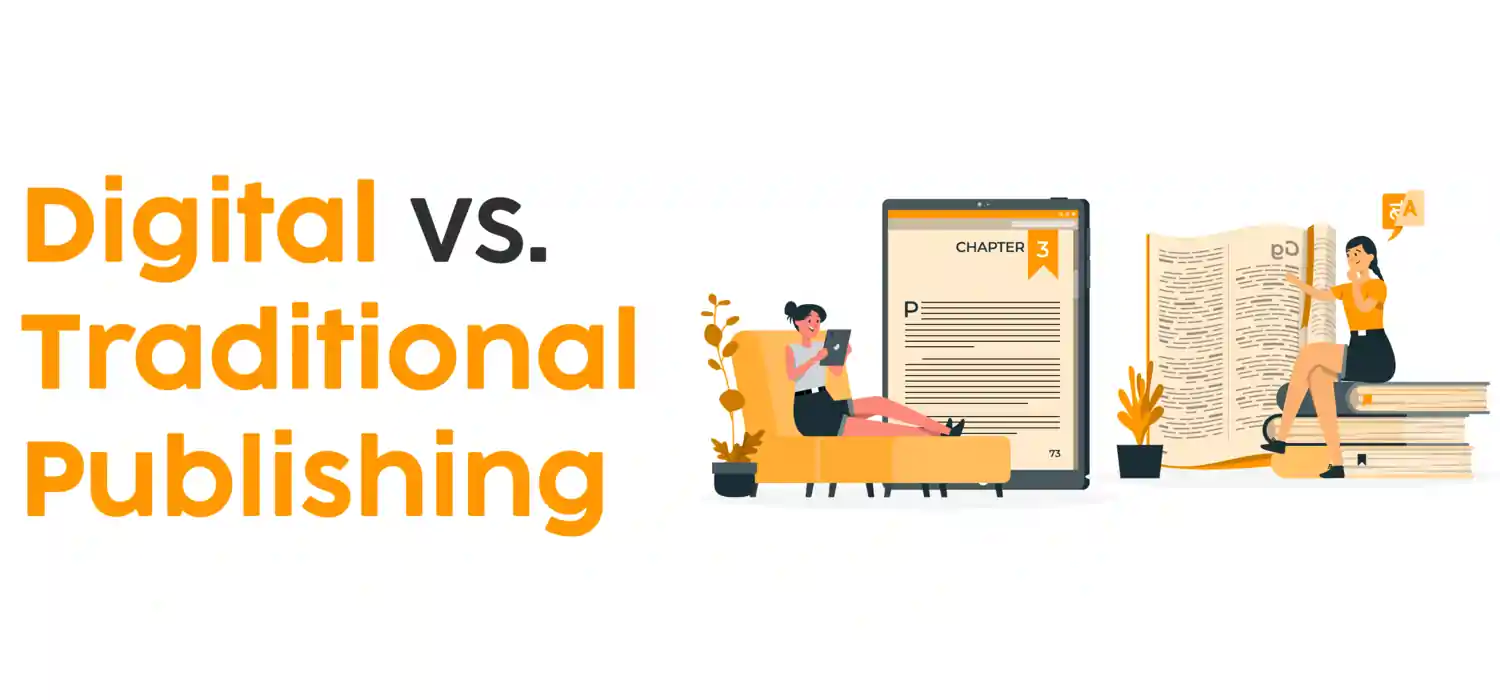Digital publishing is cost-effective, eco-friendly, and offers higher royalties, while traditional publishing provides a tangible experience but incurs high costs and longer processes.
Highlights
An enthusiastic developer and skilled business management expert with over a decade of experience in the field

Nowadays, there are two primary options for most writers and content creators: digital and traditional publishing. Each direction has its advantages and disadvantages, that can have an effect on the success, reach, and control a creator has over their paintings. In this article, we will discuss the differences between these methods, supporting writers, businesses, and publishers to make informed selections.
Digital publishing is passing out content via online platforms, consisting of e-books, websites, and digital magazines. With the development of the website and mobile devices, digital publishing has become low-priced and famous amongst writers and readers.
Accessibility: Digital publishing gives people an opportunity to read the material they need or want at any place in the world. Regardless of whether people use a smartphone, a tablet PC or an e-reader, those works are accessible to anyone who has an Internet connection. This accessibility extends the possibility of an author’s work to be accessed by anyone including the entire world.
Cost Productivity: Digital publishing, in comparison with traditional media publication does not necessarily have to be costly. No print and logistics are involved since it is also an ‘email to email’ model, cutting costs. It is an interesting possibility for independent writers and minor publishers because they do not need a large amount of money to invest initially to enter this market as the e-books or online articles can be self-produced
Speed: The process of digital publishing is often faster than traditional publishing. Authors can bypass multiple of the time-consuming steps necessary for impressing such as waiting for a publisher's blessing for typesetting and printing. With digital an author can upload content in a matter of hours or days.
Environmental Impact: Digital publishing is a paperless method that helps reduce the demand for physical supplies like paper and ink. For environmentally-conscious authors digital publication offers a way to share their be without contributing to deforestation and waste.
Digital Piracy: One main task in digital publishing is the risk of unauthorized copying or distribution. E-books, articles, and other digital substances may be effortlessly duplicated and shared without permission, potentially impacting a writer’s profits.
Less Prestige and Recognition: Although digital publishing has received appreciation, traditional publishing is regularly considered as greater credible. Books posted via the most important publishing houses still deliver more weight, especially in certain fields like academia and journalism. Authors who choose digital publishing may additionally face problems in being recognized for literary awards or other honors.
Technology Dependency: To get the right of entry to digital content, readers want gadgets like tablets, e-readers, or computers. This reliance on technology can be limiting for those without access to these gadgets, reducing the capacity readership.
Want to build a scalable website or app? Check Digittrix's expert guide and scale your business effortlessly!
Traditional publishing involves working with a publishing company to produce and distribute printed content, such as physical books, magazines, or newspapers. This process usually requires an author to submit their work to a publisher, who will then handle the editing, marketing, and distribution.
Professional Support: Traditional publishers offer professional services including editing, cover design, and marketing. This support often results in a polished final product that may attract more readers. Authors working with traditional publishers can benefit from the expertise of industry professionals helping them to make high-quality work.
Wide Distribution Channels: Traditional publishing offers broader distribution options. Done secure connections with bookstores libraries and distributors conventional publishers check that physical books reach more locations making it easier for readers to get them.
Credibility and Prestige: Being published through a reputable traditional publisher is often seen as a mark of quality and professionalism. This prestige can be particularly important for authors aiming to build a career in literature, journalism, or academic publishing.
Royalties and Advances: Traditional publishers typically offer authors an advance payment which provides financial support while the book is being completed. authors too clear royalties from hold gross sales which get work amp level reference of income if the hold performs good
Lengthy Process: The traditional publishing process can be slow, often taking several months or even years to complete. Authors must wait for approval from publishers, undergo rounds of edits, and wait for printing and distribution. For authors who want to publish quickly, this process can be discouraging.
Limited Control: In traditional publishing, authors often surrender control over various aspects of their work, such as the cover design, title, and marketing strategy. While publishers provide expertise, some authors may feel that their creative vision is compromised.
Lower Royalties per Sale: Traditional publishing often provides lower royalties than digital self-publishing. With traditional publishers taking a larger percentage of each sale, authors may earn less money per book sold, though they might gain wider exposure.
Want to boost your business online? Explore a complete guide to SEO basics for better visibility.
To understand the full scope of digital and traditional publishing, it’s helpful to compare key factors that influence the publishing experience.
Publishing is more affordable for authors. Self-publishing platforms let authors skip many expenses linked to traditional publishing, like printing and distribution. But traditional publishers cover these costs, which might attract authors who don't have money upfront.
Digital publishing reaches people worldwide, as anyone online can read digital content. Traditional publishing, however, depends on physical distribution networks, which geography and bookstore availability can limit. Yet traditional books may appeal more to certain groups, like older readers or those without digital devices.
E-books and online content are popular, but many people still like holding a real book. Physical books give readers something they can touch, which some find more enjoyable. Digital content, however, is easy to carry around and access, which appeals to readers who want to save money and have their books handy.
Real books have a physical presence that digital ones don't. You can collect traditional books, give them to your kids, or put them on display in libraries and bookstores making them feel more permanent. While you can get to digital content, it often doesn't stick around as long and might not leave the same mark on your memory.
With advancements in technology, the line between digital and traditional publishing is becoming blurred. Many traditional publishers now offer digital versions of their books, allowing readers to choose between formats. Authors are also finding ways to combine digital and traditional approaches, such as by launching digital campaigns to promote their printed works.
Some writers and publishers are going for mixed methods that blend online and old-school publishing. Take this case: a writer might put out an e-book on their own to get noticed then try to get a regular publisher for a paper version once they've got readers. This way, they can get the good stuff from both sides—reaching lots of people with online books while also getting the respect and help that come with regular publishers.
Print-on-demand services let writers make real books without having to print tons at once. These services print a book when someone buys it, so there's less worry about books not selling. This tech has made it simpler for online writers to make real books helping to close the gap between online and traditional publishing.
The choice between digital and traditional publishing depends on the goal, budget, and preferences of each author.
Budget-Friendly Publishing: E-books might be the way to go for writers who don't have much money but want to get their work out there fast. Self-publishing websites let authors put their books out with little money down giving them more options.
Creative Control: E-books let writers have a say in everything, from how the cover looks to how they sell their book. This works well for authors who want to handle all parts of getting their book out there.
Reaching a Global Audience: Digital publishing makes it possible to reach readers around the world, without the need for physical distribution.
Professional Support and Marketing: Authors who prefer professional guidance in editing, design, and promotion may benefit from traditional publishing. This path provides a structured support system that can help bring a polished work to market.
Building Credibility: For authors seeking credibility, traditional publishing offers the prestige associated with established publishing houses. This can be particularly valuable in fields where reputation is important, such as academic and nonfiction writing.
Physical Fact and Longevity: Authors who envision their work in bookstores, libraries, and personal collections may prefer traditional publishing for the physical fact it provides.
Digital and traditional publishing each have their pros and cons. E-publishing costs less and lets writers manage their work while reaching readers worldwide. Old-school publishing takes more time and money but gives authors expert help, respect, and real books you can hold.
In the end, what's best depends on what the writer wants, who they're writing for, and what they can afford. Some authors like the ease and control of e-books, while others prefer the reputation and backing of big publishers. Knowing these things helps writers pick a way to publish that fits their needs and gets their books to readers well.
In today’s world, the debate between digital and traditional publishing is more relevant than ever. At Digittrix, we specialize in building custom mobile apps or websites for the publishing industry, including interactive eBook platforms and AI-driven content recommendations.
Digital publishing offers benefits like instant distribution and global reach, while traditional publishing provides a timeless, tangible experience. Whether you want to digitize your catalog or blend both approaches, our 14 years of expertise ensure innovative solutions to keep your business competitive.
If you’re interested in learning how to effectively promote your book on social media and other digital platforms, schedule your appointment or book your consultation today by calling +91 8727000867 or writing to us at digittrix@gmail.com for all your inquiries.

Do you need help in Digital Marketing ?




Join over 1500+ businesses we've already helped!
Digital publishing distributes content online, making it accessible globally without printing costs, while traditional publishing involves producing physical books and often provides professional support.
Traditional publishing offers professional editing, design, marketing, and wider physical distribution, which adds credibility and helps reach audiences through bookstores and libraries.
Digital publishing is budget-friendly, quick, and allows authors full creative control, making it an accessible option for self-publishing and reaching a global audience.
Yes, digital publishing is paperless, decreasing demand for resources like paper and ink, which makes it a more eco-friendly option compared to print publishing.
Yes, composite models, such as publishing an e-book first and then pursuing print versions, are common and allow authors to benefit from both approaches.

©2025Digittrix Infotech Private Limited , All rights reserved.